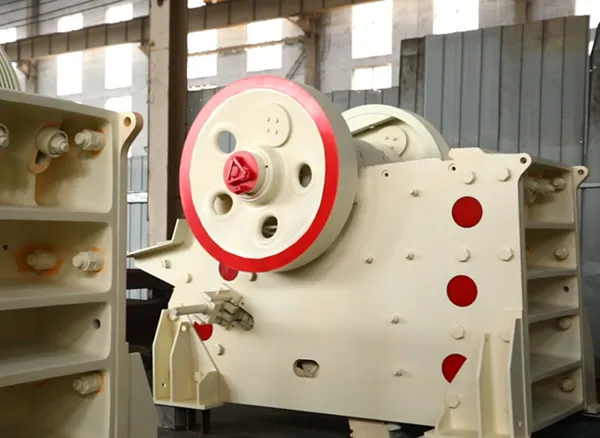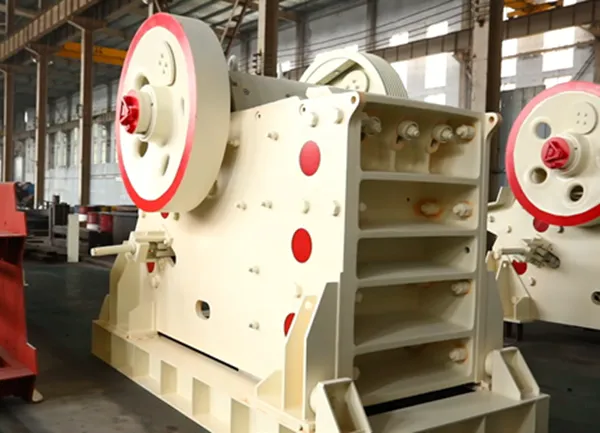Jaw crushers are robust machines essential for primary crushing in various industries, but like any heavy equipment, they can experience issues. Regular maintenance and prompt troubleshooting are key to minimizing downtime and ensuring efficient operation.

Possible Causes:
Crushing chamber/discharge port blockage: Material buildup can halt the machine.
V-belt issues: Loose, broken, or slipping V-belts.
Eccentric shaft bushing problems: Loose bushing can cause the eccentric shaft to get stuck.
Low voltage/insufficient motor power: Electrical issues can prevent the motor from driving the sheave.
Damaged bearings: Worn or damaged bearings can cause the machine to seize.
Fixes:
Clear blockages: Stop the crusher and remove any material blocking the discharge port or crushing chamber.
Check and adjust V-belts: Tighten loose V-belts or replace broken ones.
Reinstall/replace bushing: If the eccentric shaft bushing is loose, reinstall or replace it.
Adjust voltage: Ensure the working voltage meets the motor's requirements.
Replace bearings: If bearings are damaged, replace them.
Possible Causes:
Incorrect feed size: Material fed into the crusher is too large, causing clogging.
Worn jaw plates: Worn or unevenly worn jaw plates reduce crushing efficiency.
Improper settings: Incorrect eccentric speed, stroke length, or discharge opening settings.
Clogged discharge chute: Material buildup in the discharge chute can cause back-pressure.
Incorrect relative position of jaw plates: The tooth grooves of the movable and fixed jaw plates are misaligned.
Voltage too low: Insufficient power to the motor.
Fixes:
Control feed size: Ensure feed material is within the manufacturer's recommended range. Use screening devices before the crusher if necessary.
Replace worn jaw plates: Regularly inspect and replace jaw plates when wear exceeds the limit.
Adjust crusher settings: Refer to the manufacturer's guidelines to adjust parameters like discharge opening, eccentric speed, and stroke length.
Clear discharge chute: Regularly inspect and clean the discharge chute. Consider vibrating feeders for smooth material flow.
Adjust jaw plate position: Adjust the relative position of the fixed and movable jaw plates to ensure proper bite.
Adjust voltage: Ensure adequate power supply to the motor.
Possible Causes:
Loose bolts: Vibrations can cause bolts on the frame, jaw plates, or other components to loosen.
Worn jaw plates: Worn or uneven jaw plates can cause grinding noise.
Foreign objects: Small rocks, metal fragments, or other foreign objects in the crushing chamber.
Bearing problems: Worn, damaged, or insufficiently lubricated bearings.
Toggle plate issues: Toggle plate detached, broken, or improperly installed; tension spring issues.
Flywheel issues: Flywheel swinging significantly, key damaged or loose.
Improper installation/unbalanced parts: Can lead to general excessive vibration.
Fixes:
Tighten bolts: Regularly check and tighten all bolts to the manufacturer's recommended torque.
Inspect and replace jaw plates: If worn, replace jaw plates. Ensure proper clearance.
Remove foreign objects: Immediately stop the crusher and remove any foreign objects. Install proper screening to prevent future entry.
Check and lubricate bearings: Ensure adequate and correct lubrication. Replace worn bearings. Check for misalignment.
Inspect and adjust toggle plate: Check for wear, damage, or detachment. Replace or reinstall as needed. Adjust tension springs.
Check flywheel: Tighten or replace damaged/loose flywheel keys.
Ensure proper installation: Verify the crusher is installed on a solid foundation and that moving parts are balanced. Consider vibration-damping pads.
Possible Causes:
Insufficient lubrication: Not enough grease or incorrect type of lubricant.
Over-lubrication: Too much grease can also cause overheating.
Contaminated lubricant: Dirty or contaminated oil/grease.
Bearing wear/damage: Worn or damaged bearings.
Bearing bush too tight: Bearing bush pressed too tightly.
Eccentric shaft issues: Eccentric shaft stuck due to a loose bushing.
Fixes:
Check lubrication: Refer to the manual for the correct type and amount of grease. Apply grease regularly (e.g., ¼lb per bearing every eight hours, often at the end of the shift).
Clean/replace lubricant: If lubricant is dirty, clean the system and replace with fresh, clean lubricant.
Replace bearings: Replace worn or damaged bearings.
Adjust bearing bush: Adjust the pressing degree of the bearing bush using gaskets.
Reinstall/replace bushing: Address any issues with the eccentric shaft bushing.
Possible Causes:
Overload/oversize material: Main engine overloaded, or material larger than feeding size.
Non-crushable materials: Foreign materials entering the crushing chamber.
Toggle plate not parallel with pad: Misalignment can cause uneven stress.
Defective casting: Toggle plate has serious manufacturing defects.
Excessive tension spring pressure: Spring pressure is too high, leading to overload and fracture.
Fixes:
Control feed size and quantity: Ensure uniform feeding and avoid overloading. Prevent oversized material.
Prevent foreign objects: Use proper screening to prevent non-crushable materials from entering.
Ensure proper alignment: Verify the toggle plate is parallel with its pad.
Replace with quality parts: Use original manufacturer's parts for replacement.
Adjust tension spring pressure: Adjust the spring pressure according to production needs.
Possible Causes:
Loose/dropped fastening bolts: Bolts securing the jaw plates are loose or missing.
Insufficient clearance: The discharge opening is too small, causing the jaw plates to collide.
Worn adjusting wedge: The wedge used for adjustment is worn.
Casting defects: Jaw plate has serious defects.
Unqualified parts: Use of unqualified brackets or bracket pads.
Movable jaw displacement: Movable jaw is displaced and hits the side guard plate.
Fixes:
Tighten/replace bolts: Tighten or replace fastening bolts.
Adjust discharge opening: Ensure correct clearance between the jaws (e.g., 5mm-8mm).
Replace adjusting wedge: Replace worn adjusting wedges.
Replace jaw plate: If fractured or severely worn, replace the jaw plate.
Use original parts: Ensure all replacement parts meet design requirements.
Check movable jaw alignment: Verify the movable jaw is correctly positioned.

Regular Inspections: Conduct daily, weekly, and monthly inspections as per the manufacturer's recommendations. Check for loose bolts, wear, cracks, and material buildup.
Proper Lubrication: Adhere to the manufacturer's guidelines for lubricant type, quantity, and frequency. Ensure grease points are clean and accessible.
Meticulous Cleaning: Regularly remove accumulated dust, dirt, and debris from the crushing chamber, discharge chute, and other components.
Timely Replacement of Worn Parts: Monitor wear parts like jaw plates, toggle plates, and bearings. Replace them proactively before they fail to prevent further damage and downtime. Keep spares on hand.
Operator Training: Ensure operators are properly trained on safe and effective operation, as well as basic maintenance procedures.
Maintain Feed System: Ensure consistent and appropriate feed size and rate to prevent overloading and blockages.
Keep Records: Maintain detailed logs of all maintenance activities, inspections, and parts replacements. This helps track equipment history and plan future maintenance.
By following this troubleshooting guide and implementing a proactive maintenance schedule, you can significantly improve the longevity, efficiency, and safety of your jaw crusher operations. Always refer to your specific machine's manual for detailed instructions and recommendations.
Impact Crusher Wear Parts Replacement: Boost Performance, Extend Lifespan, and Minimize Downtime
2025-11-08 16:16Energy-Saving Cone Crusher: Purchasing Guide and Core Advantages Analysis
2025-10-27 08:27High-Performance Cone Crusher: The Rock-Breaking Powerhouse from Giant Rock Coarse Crushing to Premium Fine Crushing
2025-10-20 05:48Cone Crusher Installation and Operation Guide: Optimize Your Production Efficiency
2025-10-13 07:36Address: Luoyang Luoxin Industrial Park, Henan,China
E-mail: sales@yd-crusher.com
Phone: 86-139-3993-0123

Yude
Mechanical
Create the greatest value for customers
Provide the best quality products and services
86-139-3993-0123
sales@yd-crusher.com
Luoyang Luoxin Industrial Park, Henan,China